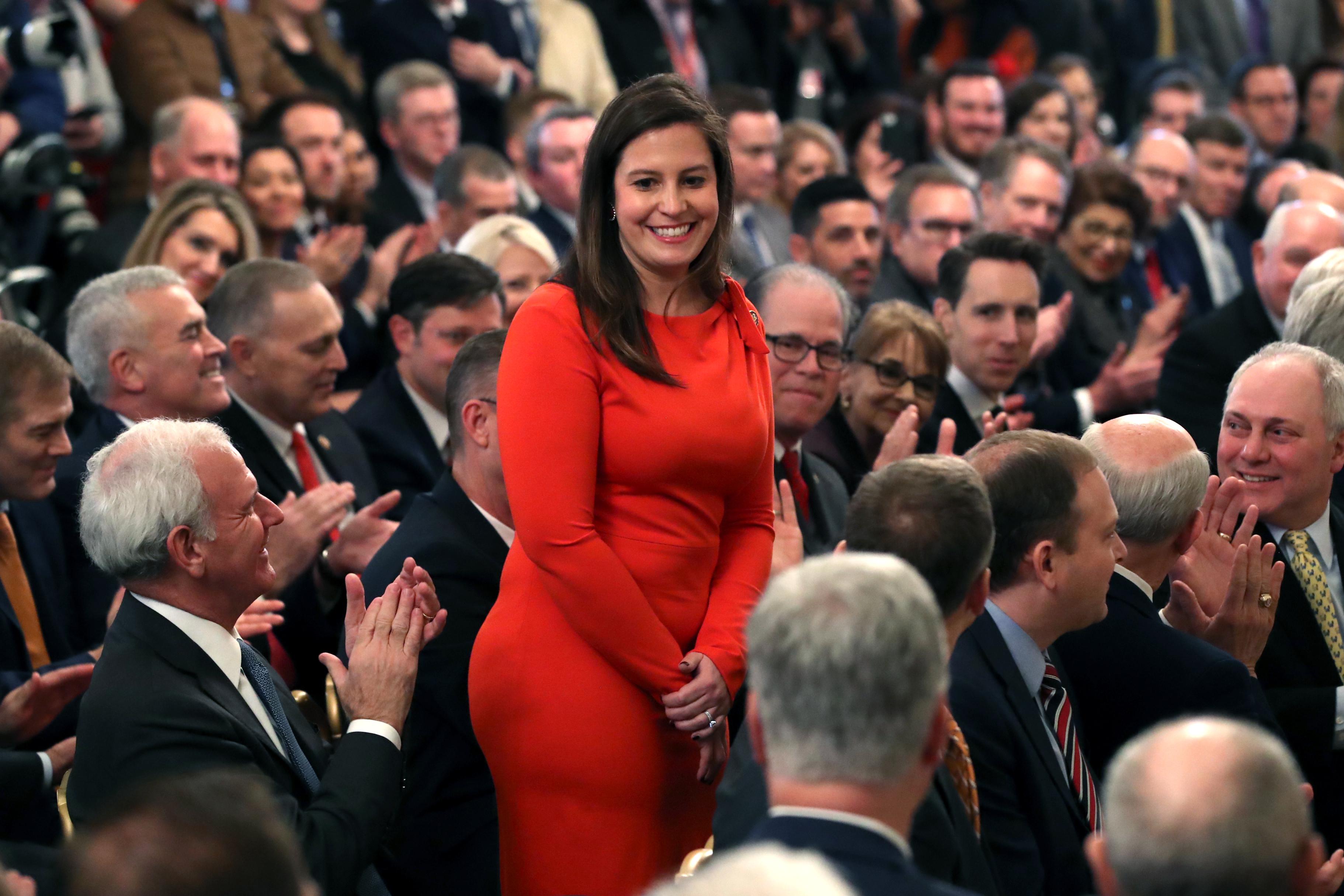It all moved very quickly.
On Tuesday morning, House Minority Leader Kevin McCarthy signaled in a Fox News interview that he was ready to throw Rep. Liz Cheney—the conservative movement scion and No. 3 House Republican who’s been vocal in her criticism of Donald Trump’s stolen-election narrative and incitement of the Capitol riot—to the wolves. Her persistence in pushing back against the former president’s lies had become a messaging distraction.
McCarthy was doing more than giving his tacit permission for the conference to overthrow Cheney. He was orchestrating her replacement. GOP leaders didn’t want their top woman in leadership replaced with another white guy—yes, this prompted some grumbling among advancement-minded white guys—so McCarthy worked to get ambitious members like the Republican Study Committee chairman, Indiana Rep. Jim Banks, to stand down. McCarthy and his whip, Steve Scalise, worked to consolidate support behind New York Rep. Elise Stefanik, and by Wednesday morning, Stefanik had earned Trump’s “COMPLETE and TOTAL Endorsement for GOP Conference Chair.”
The vote to remove Cheney as conference chair, followed by a vote to elect Stefanik, could come as soon as next week. It is just about a done deal, and Cheney isn’t really attempting to rally support to save herself.
If the House Republican conference were simply concerned about carrying out its consensus message, Stefanik would be an unexpected standard-bearer.
Stefanik, representing a vast district of upstate New York’s North Country, was first elected in 2014 and was at the time—until Rep. Alexandria Ocasio-Cortez’s election two cycles later—the youngest woman elected to Congress in history, at 30. A former George W. Bush administration aide, Stefanik was bred in the GOP establishment, and she developed a relatively moderate voting record in a purplish district. Instead of being a bomb-thrower, she built a serious reputation and accordingly earned positions on the Armed Services and Intelligence committees.
Her district drifted redder under Trump, though, with its Cook Political Report Partisan Voter Index going from R+4 to R+8 between 2017 and 2021. While Stefanik still often broke from the majority of House Republicans on policy issues, she amplified her Trump support elsewhere. She made a national name for herself as one of Trump’s staunchest (and most stunt-driven) defenders during his first impeachment in late 2019, and she supported his last-ditch Texas lawsuit to overturn the 2020 election. She pledged to object to four states’ electors on Jan. 6, but only got the opportunity to object to Pennsylvania’s following the afternoon riot.
For a decade, House GOP leadership politics revolved around whether a candidate was conservative enough to satisfy the right flank of the party. Speaker John Boehner’s perceived interest in cutting deals with Democrats was a constant source of tension that ultimately did him in. Following Boehner’s retirement in 2015, the Freedom Caucus essentially vetoed McCarthy’s ascension to the top post, and the right agreed to Speaker Paul Ryan as a compromise choice. Scalise’s ascension into leadership, too, was the result of a negotiation with conservatives.
The breezy, 24-hour consolidation around Stefanik is about as stark an end to that era as there is. Yes, would-be leaders still have to get signoff from the same right flank. But that signoff doesn’t have anything to do with whether their policy views are adequately conservative.
By any of the measures the Freedom Caucus cared about before 2017, Stefanik’s leadership bid would be a nonstarter. She has a lifetime score of 48 percent with Heritage Action, the conservative pressure group, compared with the average House Republican’s score of 85 percent; Cheney’s score, meanwhile, is 80 percent. Stefanik voted, most notably, against the Trump tax cut package in 2017, and she has called for a repeal of that law’s cap on the state and local tax deduction. That’s something that plenty of Democrats, too, want to repeal, and because such a restoration would primarily benefit the wealthy, Republicans are planning to hit them hard on it. One might think that Stefanik’s entry into leadership, then, would complicate her ability to carry out that particular message.
Along with her generally shaky conservative credentials, Stefanik was not a notable supporter of Trump’s own policy positions. Throughout the Trump administration, she regularly broke from Trump, while Cheney stayed more or less in lockstep with the president. Stefanik voted to block Trump from breaking from the Paris climate accord, to reauthorize the Export-Import Bank (something conservatives used to get extremely mad about, all of a few years ago), to provide disaster aid for Puerto Rico, and to provide additional money for the Postal Service. She voted for the Equality Act (in 2019, at least). Just this year she voted for the Farm Workforce Modernization Act, which would offer a path to legal status for undocumented agricultural workers and has been derided by the usual suspects as “amnesty.”
The vote that really stands out, though, in this vibe-based discussion of how “Trumpy” a member is, was one she took in 2019. When Trump used an emergency declaration to repurpose otherwise-appropriated money to build his border wall, Stefanik was one of 13 House Republicans who voted to repeal the emergency. Cheney was not.
What does this say about the path to leadership now? You don’t have to be consistently conservative on policy, as Stefanik breaks from the conference consensus more often than Cheney does. Nor does it even mean being there on core motivating issues behind “Trumpism” like the wall and reduced immigration. What the path requires, now, is purely loyalty to Trump himself: at a minimum, to keep your mouth shut about Trump’s worst behavior and—even better—to defend it. That’s where the base energy is to make you a star, and that’s how to get Trump’s support. Stefanik may be off-message on a host of issues that used to matter, but she’s on-message on the only thing that still counts: She’s willing to lie for Trump.

